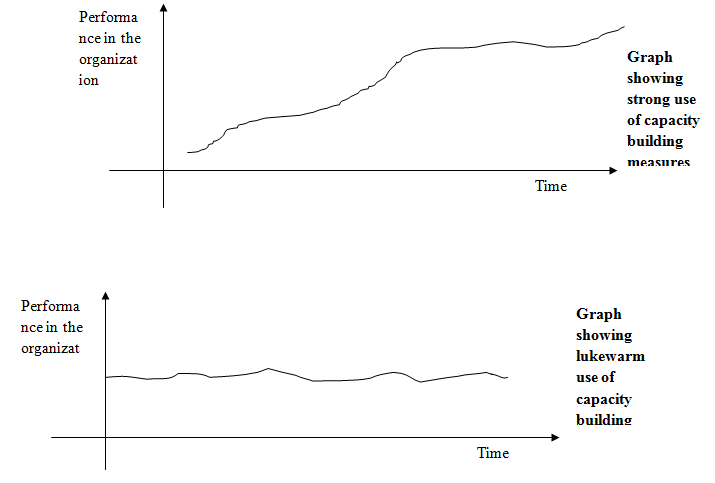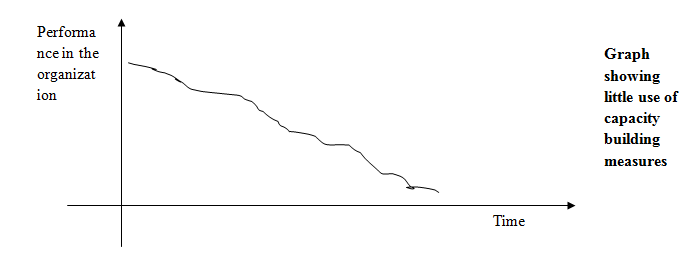Abstract
Companies have tended to focus a lot on philanthropy as one way of marketing themselves. This has been equated to capacity building in myriad of ways.
However, the term capacity building can be viewed from various perspectives. For instance, building cooperation and coordinated minds in an organization is one form of capacity building. The latter starts from within an organization before taking the shape of social responsibility.
While capacity building has several definitions and various concepts, the most outstanding feature of this organizational feature is that it enhances unity. In an organization, capacity building means bringing together all players in the organization for purpose of driving the organization from one level of operation to another.
Therefore, all organizational players must agree to form one channel of development. There are various means of building capacity in the organization. One way is by developing a strong culture full of positive values, beliefs and norms to be followed by all employees.
After coming up with one mind that is directed towards improving the performance of the organization, employees and other stakeholders can then focus on offering community assistance. This will then translate to community building or social responsibility.
American Civil Liberty Union is a non-profit organization focused on enhancing human rights among the public. However, the company may not succeed if it does not invest in capacity building in the organization. While the company has tried to its best to enhance this concept, it has not succeeded to levels that can make all proud.
Therefore, there is need to change quite a number of issues for purpose of building from that front. This paper analyzes the concept of capacity building and how it has been applicable in this organization. The paper also explores some of the approaches which can help build more of capacity in the organization.
Company: American Civil Liberties Union
Capacity building is capable of bringing in some harmonization amongst key players of an organization. At the American Civil Liberties Union (ACLU), the department tasked with maintaining capacity building has done significant work.
As an employee in the department, I have experienced some ways of maintaining togetherness in the company, which has led to harmonization in the company. The company has faced off tumultuous times like the Financial Crisis of 2009.
This company has used a number of skills in building strong capacity amongst the employees and utilization of technology. One way the company has done this is by training of organizational employees and enhancing cooperation. The company has made it as a conceptual process to develop within the company by putting a major focus on the people in the organization.
Employees in various departments are coordinated in a way that brings even development in the organization. Some of the directors in the company include the development director, the Staff Attorney, Paralegal person, the legal fellow, and the communication director, the Administrative Assistant, development associate, legislative director, executive assistant and the field director among others.
The deputy director is the head of a department tasked with enhancing capacity building in the organization. Working under Mary Beijian; the deputy director in the company is fulfilling because it gives a chance to build the company from within.
The policy in the company is to always be on the upward trend towards organizing strategies plus some public policy lobbying. The bottom line is to establish good links between various members of the staff in the company and another link with the public. Prior to moving to the department of deputy director, she was tasked with improving affirmative actions.
However, it is the Organizing & Community Engagement Director who comes directly with issues touching on capacity building in the company. Some of the efforts that have been taken are the implementation of engagement with communities, instituting recruitment programs, general capacity-building efforts, effective planning for the human resource persons and coming up with strategies to enhance grassroots participation.
There are also some advocacy campaigns that are meant to bring together company membership, especially in the organizational employees and managers. The communication director is tasked with communicating important details that enhance capacity building in the company. Laura Saponara is the Communication director and is tasked with coming up with crucial measures that would ensure all members of the organization are informed of major decisions.
The biggest advantage that has been brought in the company as a result of enhancing organizational capacity building is the social impact. There is a common language in the company in terms of talking from one front. Due to effective distribution of important information, everybody in the organization becomes the image seller. That is, they understand all what the organization stands for and therefore act as the image sale agents.
Capacity building has helped the company improve in productivity. Mostly, this has been brought about by effective training programs for the employees and improving the social fabric amongst the employees.
When the company employees speak from one front, mistake is corrected in one accord and the employees are able to improve on productivity. Everybody in the organization acts like an owner, where, the spirit and determination to succeed or perform in the organization is evident in the eyes and faces of the employees.
Concept of Capacity Building
According to Maurrasse (2004), capacity building is a modified form of social responsibility. However, it focuses more on building energy and cooperation in the organization. It is this energy and cooperation that is then transmitted to social responsibility and community building.
Maurrasse (2004) writes that it is agreed in any organization and mostly the non-profit organizations that there is insufficient attention paid towards building the organizational capacity. However, organizations are moving towards putting a strong partnership and cooperation before the energy could be reinvested in performance.
There are some crucial parts of capacity building that should not be ignored. According to Judge (2011), these measures are extension programs of an organization, delivery capacity, adaptive capacity and improving of health amongst the workers. Mostly, the organization should first analyze its market environment and the dynamics that have come with modernity to know the kind of capacity building to initiate.
Judge (2011) puts it plainly that capacity building is making two forms of personality and minds become one. That is, bringing different lines of thinking to become one for the purposes of realizing benefits. The best outcome of capacity building is improved social fabric and impact in the organization.
Strategic leaders in the world are under intense pressure to realize good results. However, it is the employees who must put their efforts towards harmonized improved of the organizational performance. This can be done through harmonized thoughts, enhanced positive culture and improving the social fabric in the organization.
It is, however, the work of the strategic leaders to make sure that the employees think from a common front. When organizational inner capacity building is enhanced, the employees together with the management can extend to the community building through social responsibilities.
The Approach to Have Capacity Building in the Organization
Before instituting a strong sense of responsibility in an organization, there must be some steps to be followed. These steps must be coordinated well to make sure that important parts are not missed. According to Joffres (2004), there are three common forms of capacity building.
One, the capacity building at an individual level, where, a person in an organization develops within to build participative skills, enhance his or her existing knowledge and establish conditions that would improve adaptation to change. Second, the institutional capacity building, where, the organization works out some programs to improve on knowledge, cooperation, learning and performance.
The third is the societal capacity building which advocates for participation amongst its members. Some of the ways of instituting or improving capacity building in an organization is by developing a strong culture full of positive norms and values to be followed by the organizational players (Jones, 2001).
There are various factors and facilitators that contribute to sustainable development through capacity building. According to Jones (2001), these factors vary from one organization to another. However, common to these are the established organizational culture and the multi-sectoral initiatives in the organization.
Researches support participation as the best form of capacity building in the company. However, it can be recognized that before establishing participation and cooperation in the organization, there must be a positive culture. The culture in the organization must allow people to express themselves and put own initiatives freely.
This way, organizational staff and other players would have organizational ownership which is essential in enhancing cooperation. More to this, the leadership of the organization must be ready and willing to bring various minds together. There must be technical support, congruence, research activities, readiness and strong leadership to enhance capacity building.
Enhancing Capacity Building at American Civil Liberty Union
As noted earlier, there are some bits of capacity building practised at the American Civil Liberty Union. Through a number of organizational leaders, employees and other shareholders of the company are brought together in terms of thinking for the organization.
However, there are some grey areas that need to be addressed effectively. For example, this company has tended to equate high strategic management to capacity building. The company is a non-profit organization, and therefore, it depends fully on funding. The kind of capacity building that is practiced in the company is one which focuses on securing funding from interested parties.
This needs to change and focus capacity building as a form of building strong cooperation among the organizational players. Even where the company gives out a strong message to potential funders in the world, a focus on improving participation amongst the employees is crucial. At long last, funders may opt to move out simply because the company may slowly disintegrate.
Capacity building in this company is capable of strengthening the link between positive image and production. The positive image is meant for all stakeholders, while production is meant to benefit people from the program. This company is all about civil liberties, and therefore, with effective capacity building, it is possible to boost the impact. Social impact needs to be created first being creating the fabric in social responsibility.
The various managers of this company recognize the growing need of capacity building but lack the means to do so. The first thing to do is for the top management to come up with a culture that can bring the minds and people together for a focused form of productivity. Another aspect of development in terms of capacity building at this company is to enhance affirmative action and uphold various human rights.
Possible Scenarios of Capacity Building at ACLU


References
Joffres, C. 2004. “Facilitators and challenges to organizational capacity building in heart health promotion.” Qualitative Health Research, 14(1), 39-60.
Jones, M. L. 2001. “Sustainable organizational capacity building: Is organizational learning a key?” The International Journal of Human Resource Management, 12(1), 91-98.
Judge, W. Q. 2011. Building Organizational Capacity for change: The leader’s New Mandate. New York: Business Expert Press, LLC.
Maurrasse, D. 2004. A future for everyone: Innovative social responsibility and community partnerships. New York: Taylor & Francis, Inc.